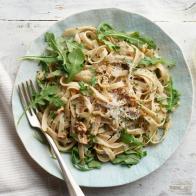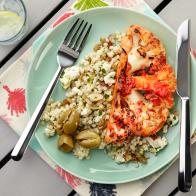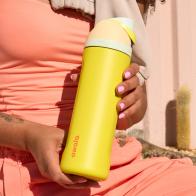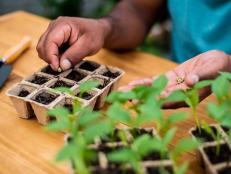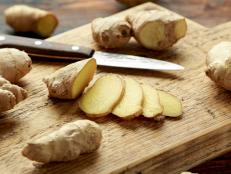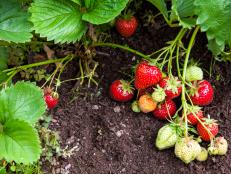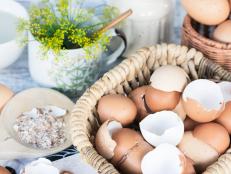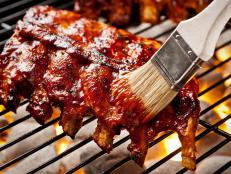How to Start Herbs from Seed
All you need to grow fresh herbs year-round is a clay pot and a sunny spot, indoors or out.

istetiana
Herbs are as much a mainstay in the garden as they are in the kitchen. Happily, many herbs are easy to grow. All you need is a packet of seeds, a clay pot and a sunny spot, indoors or out. Soil is also key, so use a good potting mix, or prepare a well-drained, fertile loam for these culinary types. Some herbs are drought-tolerant, but all seedlings need water to start off right. Be prepared to sprinkle them daily. As herbs mature, they require less fuss and care but harvesting their leaves by pinching off the top shoots will make them bushy and provide small amounts for recipes. This also prevents untimely flowering, which turns the foliage bitter. In just a few weeks or more these simple seeds will become good-looking plants that provide fresh clippings whenever needed or can be harvested to dry for later use.

Ross Woodhall
Basil
Whether it’s Genovese, Thai or Lemon, basil is super simple to start from seed. If sown directly in clay pots set in a sunny window in early spring, they will be ready to take outside after the threat of frost has passed. Sprinkle several seeds in each pot and cover with 1/4-inch of potting mix. Keep the mix moist as the seeds germinate and grow. Pinch off the top leaves to keep plants bushy and prevent flowering. Harvest the entire plant in mid-summer and sow more seeds for subsequent crops all the way through autumn.
Flat Leaf Parsley
Parsley seeds can be reluctant to sprout so soak them overnight in water before sowing in pots or a raised bed in a warm, sunny spot. Sprinkle several seeds together and cover with 1/4-inch of potting mix or soil. A rich, well-drained soil is best. Seedlings will emerge in a few weeks. Thin them to one or two of the strongest plants and let those grow. Hold off on harvesting until each plant sports a dozen or more stalks, then clip as needed. In warm regions parsley will overwinter, emerge in spring, grow again and flower.
Dill
Direct seeding dill outdoors is best, though a small plant will form in a pot. Sprinkle the seed on the surface of rich, organic soil and cover it with a thin layer of peat moss or potting mix. Keep the surface moist and in a week or two, seedlings will sprout. Dill grows fast, so the best way to harvest it is to let it fully mature, then pull the entire plant. Sow more seeds every three to four weeks from mid-spring through summer for a steady supply. Dill grows tall so plant it towards the back of the garden, or in a large pot with plenty of room for roots.
Cilantro
Spring and fall are the best time to sow cilantro because these cool-season herbs tend to bolt (flower and set seed) in hot weather. Sow in rich, fertile soil 1/2-inch deep and two inches apart. Thin them to every third plant once they are a few inches tall and grow them on. Pinch and clip the new stems regularly to prevent flowering. If they do bloom, let the flowers finish form seeds. The seeds are ready when the plant dies back and turns brown. Collect them then and either sow them in the garden or put them on your spice rack, because cilantro seeds are coriander!
Summer Savory
Sow summer savory seeds shallowly and an inch apart, then press them into place. Do not bury the seeds, they need sunlight to germinate. Direct sowing in the pot or on the ground is easiest. For best results, keep the soil or potting mix moist but not soggy. In a matter of a few weeks there will be leaves to harvest for soup and dressing recipes. Right before the plants form flower buds, pull it from the ground and hang it in a warm, dark, ventilated space to dry for later use.
Chervil
Also called French parsley, chervil tastes a little like tarragon with a hint of anise. A supply of delicate chervil leaves can be maintained throughout the season by sowing seeds in a pot or directly on the ground every three weeks starting in spring. Wait until their leaves are fully open and tender. If the plant starts to bloom, it’s too late, those leaves will be bitter. To avoid this, grow chervil in part-shade or a cool spot, then harvest mature plants for drying before they flower.
Borage
Easy and beautiful, borage is a fan favorite among herb gardeners. Any sunny spot or pot is the perfect place to grow this useful herb. Sow seeds right on the surface, cover with a 1/4- to 1/2-inch of soil and press in place. Plants can grow up to two feet tall in six to eight weeks, but you can harvest their tasty leaves and edible flowers all along the way. As the plants mature, allow the top two inches of soil to dry out between watering. Borage forms a deep tap root, so for best results grow it in a tall pot or a raised bed.
Chamomile
There is no better way to complete a day in the herb garden than with a cup of chamomile tea. One packet of seeds can provide enough plants and future seeds to keep you in chamomile for years to come. Sow directly on the surface of a sandy, well-drained soil or potting mix and keep moist until germination – about seven to 14 days. Two weeks later the plants will begin to bloom, and the flowers will be ready to pick. Remove just the blossoms and set them in a warm room to dry. Let some flowers persist on the plants until they finish and set seed. Use these seeds for subsequent crops throughout the season or save them for next year.
Related Content:
